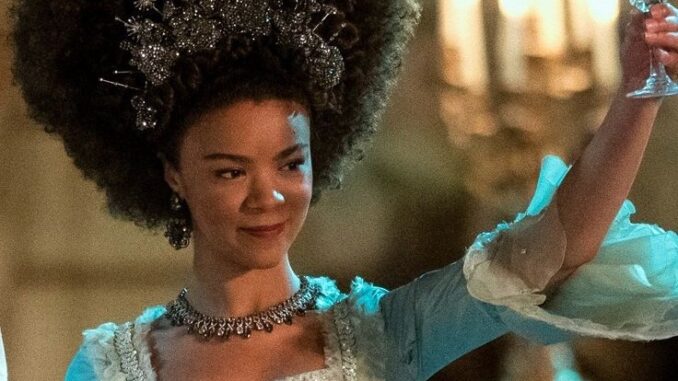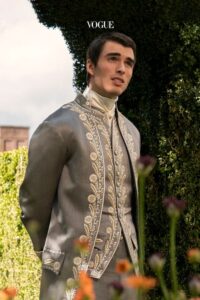
Behind the “fiction inspired by fact” of the Bridgerton story.
Any marriage that lasts nearly six decades is certainly a story for the ages, especially if it’s rooted in reality, like the one at the center of Queen Charlotte: A Bridgerton Story.
The origins of the 57-year romance between Britain’s King George III and Queen Charlotte are the subject of the series, which was created by Shonda Rhimes and based on characters first introduced on-screen in Bridgerton.
While the British king and queen are very real figures, the six-episode interpretation of their romance is fictional. As the series reminds you in its opening moments, “It is not a history lesson. It is fiction inspired by fact.”
Portrayed in their 1800s iterations by Golda Rosheuvel and James Fleet and as their 1700s predecessors by India Amarteifio and Corey Mylchreest, the royal couple aren’t all that was pulled from history books to create the world of Queen Charlotte. Read on for more details about the series’ real-life inspiration.
Is Queen Charlotte real?
While Queen Charlotte — aka (formerly) Princess Sophia Charlotte of Mecklenburg-Strelitz — was certainly real, the character of Charlotte, played in different eras by Amarteifio and Rosheuvel, is Rhimes’ creation. “We’re very clear about this world and … that this is not a history lesson. This is fiction inspired by fact,” the creator and executive producer told Netflix. “It’s very important for me that people understand that, because I’m telling the story of Queen Charlotte of Bridgerton, not of Queen Charlotte of England.”
Of course, they do share things in common, as the real Queen Charlotte was also born in the German territory of Mecklenburg-Strelitz in 1744 and left her home country to marry Britain’s King George III in 1761. That garden wall attempted escape? That’s all Rhimes.

Was Queen Charlotte Black?
As Queen Charlotte executive producer and director Tom Verica told Netflix, “Many historians believe that Queen Charlotte was of mixed cultural heritage.” In fact, historian Mario de Valdes y Cocom argued in 1997 that the queen “was directly descended from Margarita de Castro y Sousa, a Black branch of the Portuguese royal house,” but the intricacies of what that means is still debated by historians today.
For example: “de Castro [y] Sou[s]a’s ancestry is traced from the 13th-century ruler Alfonso III and his lover Madragana, whom Valdes believed was a Moor,” according to Smithsonian magazine. While the Moors of Spain came from North Africa, in that time the Moors didn’t necessarily refer to race but rather to religion.
The continued conversation around Queen Sophia Charlotte’s race inspired the creative team of Queen Charlotte. “We wanted to take that in a different direction than what the history books have said happened — which was basically to bury that and not deal with it. We wanted to shine a light on that element,” Verica said. This decision led to Queen Charlotte’s Great Experiment, which is unique to the Bridgerton universe.
Was there Black nobility in London at the time?
Rhimes drew inspiration from the book Black London by Avril Nanton and Jody Burton, she told Shondaland.com. “I made Agatha [Arsema Thomas] and Lord Danbury [Cyril Nri] off the idea that there were African royalty sending their children to boarding schools in England,” she said. “That was something I’d never known either — that there were these incredibly wealthy Africans living in London in a parallel life.”
Which British monarch did Queen Charlotte marry?
King George III and Queen Charlotte were married on Sept. 8, 1761, and their coronation took place weeks later on Sept. 22.
How many children did Queen Charlotte have?
Charlotte and George had 15 children together, six daughters and nine sons. Two did not survive to adulthood.
George, Prince Regent, 1762–1830
Prince Frederick, 1763–1827
Prince William, 1765–1837
Charlotte, Princess Royal, 1766–1828
Prince Edward, 1767–1820
Princess Augusta Sophia, 1768–1840
Princess Elizabeth, 1770–1840
Prince Ernest, 1771–1851
Prince Augustus Frederick, 1773–1843
Prince Adolphus, 1774–1850
Princess Mary, 1776–1857
Princess Sophia, 1777–1848
Prince Octavius, 1779–1783
Prince Alfred, 1780–1782
Princess Amelia, 1783–1810
Did Queen Charlotte’s children really not produce any heirs?
As Lady Whistledown (Julie Andrews) laments in the first episode of Queen Charlotte: A Bridgerton Story, the death of the prince regent’s only legitimate child means there is no royal heir. In real life, after Princess Charlotte Augusta of Wales died during childbirth in 1817, along with her son, the next legitimate heir did not come until the future Queen Victoria was born to Prince Edward in 1819.
